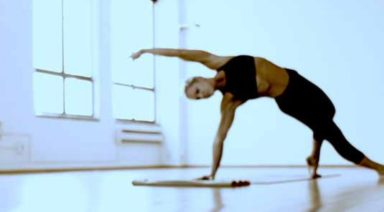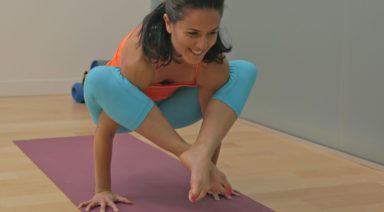Parsvottanasana: Intense Side Stretch Pose

ADJUSTMENTS | BENEFITS | SEQUENCING | SANSKRIT | STEPS
From lengthening the spine to stretching the legs to calming the mind, there’s a little bit of everything in parsvottanasana (parsh-voh-tahn-AHS-ah-nah) Also known as intense side stretch pose or pyramid pose, this shape is helpful for finding balance while stretching hamstrings.
Parsvottanasana requires a combination of flexibility, strength, and patience. With the help of props such as blocks or a wall, this pose becomes accessible for everyone.
ADJUSTMENTS/MODIFICATIONS:
- Blocks: Place hands on blocks to help keep the torso long.
- Wall: Place hands on a wall in front of you to work on strengthening the muscles of the back.
- Heart opening variation: Take the hands in reverse prayer position behind the back to stretch and open your shoulders and chest while also challenging your balance. If reverse prayer isn’t accessible, you can still bring the arms behind the back, reaching for opposite elbows instead.
- Adjust your stance: If the back heel is lifted off of the floor, shorten the stance so you can push through the heel to activate the back leg. For more stability, widen your stance.
STEP-BY-STEP:
- From the top of your mat, step your left foot back about one legs length. Keep your right foot pointing forward and adjust your back foot so that it turns out at a 45 degree angle. Draw a straight line from your front heel to your back heel and make sure that the middle of your right knee lines up right over the middle of your right ankle.
- Begin to turn your torso forward, aligning your chest, shoulders, and ribs with the front of your mat. Ground through your back heel as you rotate the upper inner thighs of both legs back. Broaden across your collar bones as you draw your shoulder blades down and in towards your spine.
- With a long spine, hinge from your hips so that your torso moves closer toward your front leg. Once your spine is level with the floor, place your hands on either side of the front foot, either on the ground or on blocks.
- Engage your thighs and keep your sternum lifted and shining forward.
- For balance, use the base of the big toe and the inner part of the heel of your front foot like a magnet with the floor. Continue grounding through the heel of your back foot, ensuring that your thigh stays active so that you don’t lock your knee.
- If you have the flexibility to fold forward more while keeping the front and back of the torso long, start to bring the chest and belly towards the thigh.
- Stay in the posture for up to 30 seconds before rising back up. Release the posture and practice on the other side.
PREPARATORY POSES:
- Downward-facing dog | Adho mukha svanasana
- Head to knee pose | Janu sirsasana
- Standing forward fold | Uttanasana
SEQUENTIAL POSES:
- Revolved triangle | Parivrtta trikonasana
- Warrior I | Virabhadrasana I
- Standing splits | Urdvha prasarita eka padasana
COUNTER POSES:
- Half lord of the fishes | Ardha matsyendrasana
- Dancers pose | Natarajasana
- Wide-seated angle pose | Upavistha konasana
SANSKRIT:
- Parsva = side
- Ut = intense
- Tan = stretch, extend
- Asana = pose
PHYSICAL BENEFITS:
- Stretches hips and hamstrings.
- Strengthens leg muscles.
- Thought to help stimulate digestion.
Legal Disclaimer Before participating in any exercise program or using any fitness products or services that may be described and/or made accessible in or through the Gaia Website and/or the Services, you should consult with a physician or other healthcare provider. Read more about Gaia’s Terms Of Use.
Ardha Matsyendrasana: Half Lord of the Fishes Pose

ADJUSTMENTS | BENEFITS | SEQUENCING | SANSKRIT | STEPS
Ardha matsyendrasana (ARE-dah MOT-see-en-DRAHS-ah-nah) is an approachable twist that opens the shoulders and chest. A good antidote for too much sitting and symptoms that come with overusing technology, half lord of the fishes pose has the ability to increase energy in the body while also stoking the digestive fire in your belly.
Philosophy + Origin
Matsyendra is often recognized as one of the original founders of hatha yoga in yogic mythology. He was said to be a baby who was thrown into the ocean after his parents rejected him. The story of Matsyendra reminds us that it’s often the parts of our personal stories we don’t like or don’t want to accept that can be the most beneficial, especially on the path to becoming a yogi or yogini. Rather than conceptualizing the twist to be a purge of what is unwanted or unnecessary, think of the detoxification as a purification, an opportunity to take what was once viewed or understood as “bad” and transform it into something that is helpful on your personal journey.





































